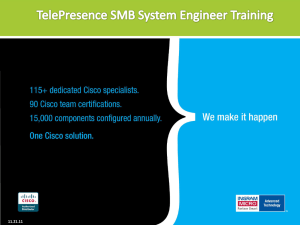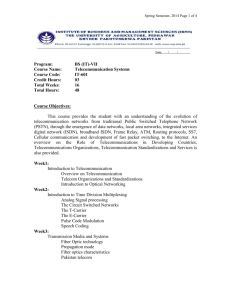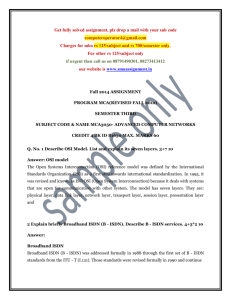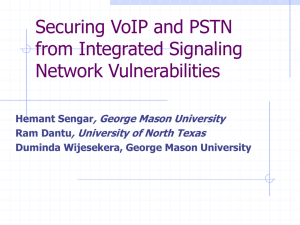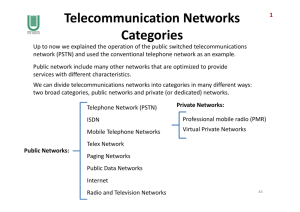haider
advertisement
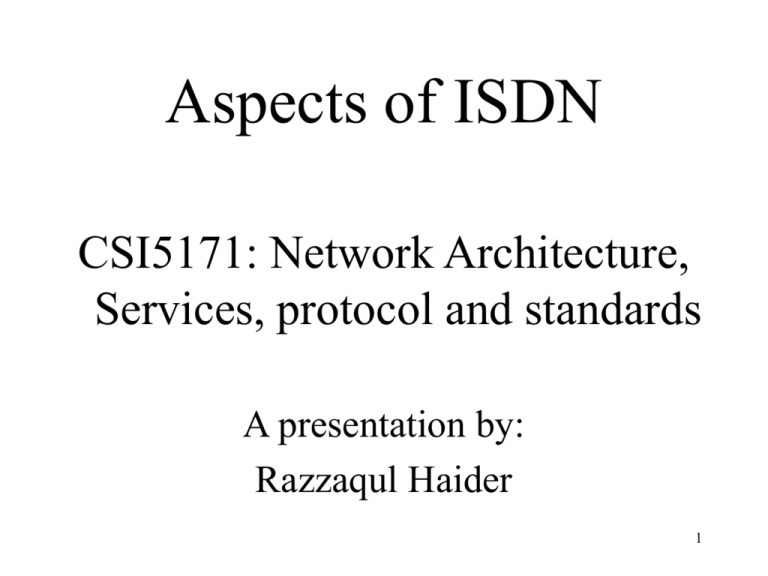
Aspects of ISDN CSI5171: Network Architecture, Services, protocol and standards A presentation by: Razzaqul Haider 1 Introduction • ISDN stands for Integrated services Digital network • It provides end-to-end digital connectivity for voice and non-voice services • ISDN provides all the services through a single interface • Use out-of-band signaling • Protocol used by ISDN is layered protocol 2 ISDN Architecture USER ISDN USER Fig.1: ISDN architecture ISDN offers 8 main switching and functional capabilities 3 ISDN Capabilities • • • • • • • • Local Connection related function 64 kbps circuit switched capabilities 64 kbps circuit non-switched capabilities Packet switching capabilities Switched capabilities > 64kbps Non-Switched capabilities > 64kbps Frame mode functional entities CCS capabilities (SS7) 4 Channels and Access Interface • Two types of channels – D-channel (Data channel): usually carries signals @ 16 Kbps or 64 Kbps; also can carry packet data – B-channel (Bearer channel): carry information for user services @ 64 Kbps • Two access interfaces – BRI (Basic Rate Interface): 2B + D (16 Kbps); intended for home use – PRI (Primary Rate Interface):23B+D (64Kbps) in North America; 30B+D in Europe; intended for business use 5 ISDN Reference Configuration LE T S TE1 NT2 R TE2 U V LT ET NT1 NT1 SS7 NT1 TA Fig. 2: ISDN devices and common reference configurations TE1: Terminal Equipment Type 1 TE2: Terminal Equipment Type 2 TA: Terminal Adapter NT1: Network Termination 1 NT2: Network Termination 2 LE: Local Exchange LT: Local Termination ET: Exchange Termination 6 ISDN Reference Configuration (cont’d) • ISDN recommendation describes several functional device types as shown • Each device talks to the neighbouring device(s), using certain communication protocol. • Each of these device interfaces is called a reference point and denoted by R, S, T, U and V. 7 Signaling Protocol Other Net node SS7 Voice, data ISDN Switch B-ch D-ch B-ch U S E R • Two types of signaling protocols – user- network interface protocol: through D-channel; known as DSS1 (Digital subscriber System 1); defined in three layers and – Networking (interswitch) protocol: CCS signaling by SS7, specifically ISDN User Part (ISUP) of SS7, 8 defined in 7 layers Protocol Architecture • DSS1 protocol is defined in 3 layers • SS7 protocol architecture TCAP Basic Suppl. Services Services ISUP SCCP Q.931 messages LAPD MTP I.430/I.431 9 D-channel protocol • Used to establish, maintain and terminate network connections • Provide procedures for invocation and operation of supplementary services 10 ISDN User Part • ISUP is an upper layer application supported by SS7 • ISUP provides the signaling functions required to support basic bearer services and supplementary services • ISUP uses either SCCP, which in turn uses MTP, or it uses MTP directly for message transfer • ISUP basic call control is divided into three parts: call set-up, the data/conversation phase and call clear down 11 ISDN User Part (cont’d) • Two signaling methods: link-by-link, end-to-end • ISUP Signaling Capabilities are of two class: Internationally applicable class and National use class ISUP end-to-end signaling • Capability to transfer information of end point significance • Typically used between all originating and terminating local exchanges 12 ISUP end-to-end signaling • Used to request or to respond to requests for a basic call, to invoke a supplementary or to transfer user-to-user information transparently through the network • Two methods of end-to-end signaling: SCCP method of end-to-end signaling and pass-along method of end-toend signaling • Pass-along signaling is done without requiring the service of SCCP. • Pass-along method usually used when information to be transferred relates to an existing call for which a physical connection between the same two exchanges has been established 13 Basic Call Setup Calling Party Originating Ex. Transit Ex. Transit Ex. Destination Ex. Called Party SETUP IAM IAM IAM SETUP CP CP ALERTING ACM ACM ACM ANM CONNECT ANM ALERTING CONNECT ANM CONNECT CONNECT ACK ACK ON going connection Q.931 ISUP Q.931 Fig.5: Circuit-mode basic Call setup 14 Basic Call Release Calling Party Originating Ex. DISCONNECT Transit Ex. REL RLC RELEASE Transit Ex. REL RLC Destination Ex. REL RLC Called Party DISCONNECT RELEASE RELEASE RELEASE COMPLETE COMPLETE Q.931 ISUP Q.931 Fig. 6: Circuit-mode basic Call Release IAM: Initial Address Message ACM: Address Complete Message ANM: Answer Message REL: Release RLC: Release Complete 15 Basic Call Setup/release • User initiates call by Q.931 SETUP message on the D-channel • Upon receiving the SETUP message OLE launch an ISUP IAM message to the Transit eXchange (TX), TXs generate IAM until it reaches Terminating local Exchange (TLE) • IAM contains originating point code, destination point code, Circuit identification code, etc. • Finally, the destination exchange sends a SETUP message to the called party on the Dchannel • Called party terminal equipment generates an ALERTING message • TLE then sends ISUP message ACM to the OLE through TX • After called party answers the call, TE sends Q.931 CONNECT message on the D channel, which causes the TLE to send an ISUP message called ANM 16 Basic Call Setup/release (cont’d) • ANM message at OLE generates CONNECT message to the calling party TE • Connection is established between the end users through B-channels at the originating and terminating access interfaces and network trunks between the OLE and TLE. • Call termination initiated my the message DISCONNECT from the terminal Equipment • the OLE sends an ISUP release message (REL) to release the trunk circuit between the switches • Upon receiving the REL, the destination switch disconnects the trunk from the called party's line, sets the trunk state to idle, and transmits an ISUP release complete message (RLC) to the originating switch to acknowledge the release of the remote end of the trunk circuit 17 Supplementary Services • ISDN supplementary services offer capabilities to customers that can be dynamically controlled and accessed via their CPE. • Some services have local significance and available from the local switch, e.g. conference call, call waiting, etc. • While others have end to end significance and availability depend on the capability of the switch to communicate with other switches through ISUP, e.g. number identification, User to user signaling, etc. • Users control the both type of services through signaling capabilities of the D-channel 18 Supplementary Services (cont’d) Category of supplementary services: • Number identification services: DDI, MSN, CLIP, CLIR, COLP, COLR, MCID • Call offering services: CT, TP, CFU, CFB, CFNR, CD, ECT, LH • Call completion services: CW, HOLD, CCBS • Multiparty: CONF, 3TPY • Community of interest: CUG, PNP, MLPP • Charging services: AOC, CRED, RC • Additional transfer information services: UUS 19 Conclusion • • • • • • • ISDN architecture and capabilities ISDN protocols Channels and Access Interface ISDN reference configuration ISUP signaling Message sequence flow for basic call set-up Supplementary services 20
